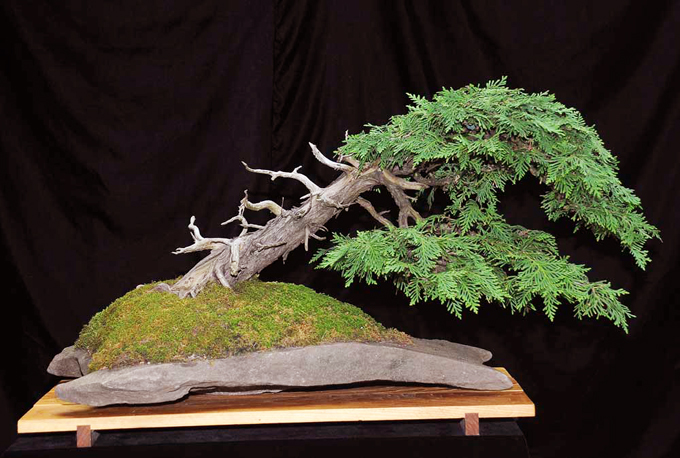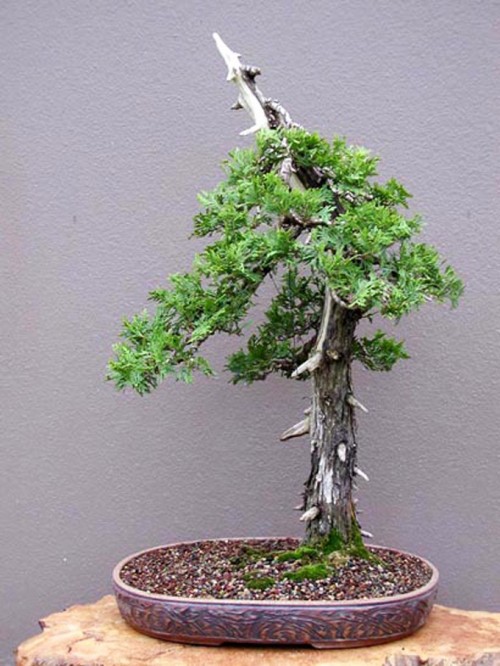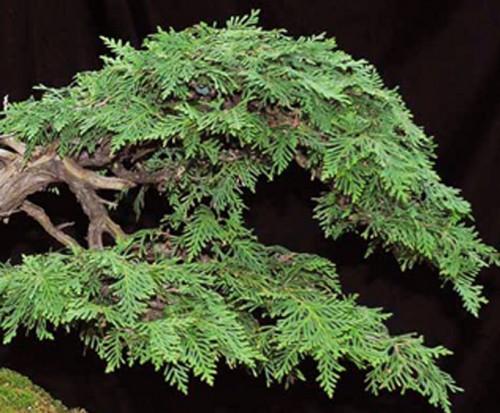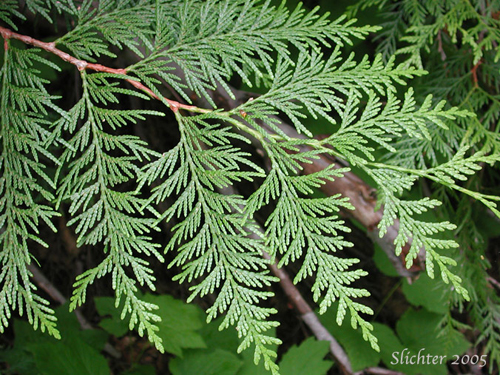 Not a great tree, but a good tree (I’d happily add it to my collection) that provides an excellent look at the beauty of Northern white cedar foliage (see below for a close-up). This type cedar often grows at the water’s edge, so you might imagine that this one is leaning out over a pond or river. You might also imagine that years of heavy snow have weighed it down. It’s a member’s tree at The Bonsai Society at Royal Botanical Gardens, in Burlington, Ontario.
Not a great tree, but a good tree (I’d happily add it to my collection) that provides an excellent look at the beauty of Northern white cedar foliage (see below for a close-up). This type cedar often grows at the water’s edge, so you might imagine that this one is leaning out over a pond or river. You might also imagine that years of heavy snow have weighed it down. It’s a member’s tree at The Bonsai Society at Royal Botanical Gardens, in Burlington, Ontario.
In keeping with our Cedar theme (true cedars and cedars in name only), here’s a peek at a couple less dramatic but worthy examples of our Northern white cedar. Both of which, in addition to other things, provide a pretty good look at cedar foliage and bark. BTW, when we say cedar in this case, we’re referring to that genus of trees that is more accurately called Arborvitae (aka Thuja).
On a personal note, I must confess to my love of our native cedars, great and humble. In fact, if it weren’t for the natural beauty of our cedars here in northern Vermont, our gorgeous landscape would be diminished. Beyond that, our Northern white cedar makes for great bonsai. They are tough as nails, and though it is possible to kill them through barbaric handling or neglect (sadly I know first hand), still, they don’t give up all that easily.
 Like the one above, this one is not as dramatic as some Cedars, but I like its rugged simplicity. And then there’s that luscious pot. You might notice that the foliage looks a little rougher than the foliage on the tree above (and below). Northern white cedars display considerable foliage variation, often on a single tree. The tree and the pot are by Sara Rayner. The photo is from an old post about Sara’s bonsai and pots at the Art of Bonsai Project.
Like the one above, this one is not as dramatic as some Cedars, but I like its rugged simplicity. And then there’s that luscious pot. You might notice that the foliage looks a little rougher than the foliage on the tree above (and below). Northern white cedars display considerable foliage variation, often on a single tree. The tree and the pot are by Sara Rayner. The photo is from an old post about Sara’s bonsai and pots at the Art of Bonsai Project.
 Northern white cedar foliage close up (from the photo at the top). It looks suspiciously like Western red cedar foliage (see below), but it isn’t. Our Northern white cedar foliage varies from tree to tree and often on a single tree.
Northern white cedar foliage close up (from the photo at the top). It looks suspiciously like Western red cedar foliage (see below), but it isn’t. Our Northern white cedar foliage varies from tree to tree and often on a single tree.
 Western red cedar (Thuja plicata) foliage. It’s a little more feathery and delicate than our Northern white ceder’s foliage, though in some cases they can be quite similar. Another notable difference is size. Western red cedars are towering trees, while our Northern whites are much more humble in size.
Western red cedar (Thuja plicata) foliage. It’s a little more feathery and delicate than our Northern white ceder’s foliage, though in some cases they can be quite similar. Another notable difference is size. Western red cedars are towering trees, while our Northern whites are much more humble in size.
Hi Wayne
Do these guys go brown (as if they have become a finished bonsai) & hold the pads in winter?
I might have one if the answer is yes.
JC
Hi John,
I’m not sure what you mean by ‘ finished bonsai’, but If I understand the rest of your question, they do not go brown in the winter.